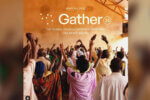In the aftermath of Hurricane Katrina, Christians have been working around the clock to help Gulf Coast residents rebuild.
Dedicated members of Joy Fellowship Church in Slidell, Louisiana, traversed miles of debris the day after Hurricane Katrina hit last August, only to find their homes and schools ransacked. Almost miraculously, however, their church building stood.
That is when pastors Larry and Leslie Roques, along with church administrator Kim Duncan, “basically kissed our lives goodbye,” Duncan recalls. “We said, ‘OK, Lord, You’ve cleared the plate; what do You want?'”
A year later, Joy Fellowship’s Sunday school rooms still bulge with products. Their congregation has shifted from 50 original members to hundreds who daily visit the church’s “drive-through” system of relief stations. Luxury SUVs and clanking trucks queue in the parking lot six days a week picking up hygiene products and food staples.
“This has redefined our church community,” Duncan says. “We still seek the presence of God and serious discipleship. We are still all about building a habitation for the Lord. It just moved to our parking lot.”
At the last drive-through station, Christians offer Bibles and prayer. More than 1,800 have prayed to receive Christ since the storm. And the group didn’t begin counting until weeks after their relief ministry began.
Volunteers are being transformed alongside storm victims. Robin Foxworth, pastor for interns at Tommy Tenney’s GodChasers ministry in Pineville, Louisiana, has worked at the site.
Foxworth, a pastor for 15 years, says Katrina has surprised him with personal blessings: “I will never be the same.”
Rebuilding a Battered City
Hurricane Katrina’s tortuous hand shattered New Orleans and the Mississippi coast, striking a region as diverse as its swamp life: a land of voodoo, gambling and wild living, but also of decent, hardworking people and many trapped poor.
“Despite New Orleans’ problems, there were always good churches there, existing in Babylon,” explains Tommy Tenney, who says a “beautiful thing” now is emerging.
One year later a consecrated, pure, new spiritual vision is rising from the depressing rubble, says Tenney, an author and founder of the GodChasers Network. Ministers who first struggled to see God’s hand in Katrina now sense a fresh wave of His Spirit. “It’s as if the area had a bath,” Tenney says. “It is redemptive.”
The storm busted up antebellum pockets of poverty and witchcraft. Its dire winds and waves led to a new monthly pastoral gathering of hundreds in south Louisiana—the Pastors Resource Council—fostering new Christian leadership. On the Mississippi coast, one group of 40 Spirit-filled pastors meets in Bay St. Louis to pray for God’s long-term revival after Katrina.
Black and white clergy rally together. Bishop Paul Morton of Greater St. Stephen Full Gospel Baptist Church surveyed one meeting with tears in his eyes, saying he had never been in a room with so many white pastors.
Christian clout is rising with unbelievers. “The church has been the one bright spot,” says Jerry Davis, a Houston pastor who established Good News Camp in the parking lot of the Tad Gormley Stadium in New Orleans City Park.
Davis has collaborated with others to distribute more than $60 million in retail goods and services. The ministry brought more than 400 semitrailers of supplies, served more than 400,000 hot meals and hosted about 15,000 volunteers.
“I have heard the city council of New Orleans excoriate government officials and even non-church organizations,” Davis notes, “only to turn to us with praise and thanksgiving for all the Christian community has done.”
Some locals are looking to Jesus who haven’t before. “A higher percent of people than ever are attending church in New Orleans,” Tenney says.
The national media and politicians now look elsewhere for high ratings, but Christians blanket this patchwork quilt of concrete slabs and saw grass, their campers, tents and volunteer youth groups everywhere.
More than 50 Pennsylvania Old Order Amish even amended their usual convictions this spring, swapping horse-and-buggies for a bus ride to the Coast.
Ben Lapp, an Independent Mennonite, said the Amish knew their roofing and framing skills were needed. “It is more blessed to give than to receive,” Lapp explains.
The Rev. Ramsey Gilchrist of The Falls Church, an Episcopal congregation in Virginia, committed his church to completely rebuild one family’s home. “This is what God is doing,” Gilchrist says as he travels the coastline. The supernatural aspect makes him want to move permanently. “You just come down and get in it, and you feel God’s presence here.”
Even as locals decry what has proven to be a frustrating, longer-than-expected cleanup process, they have noticed Christians’ long-term expressions of love.
Bill is a tough, backwoods 68-year-old from the “lost community” of swampy Pearlington, Mississippi, just across the Mississippi River near New Orleans. The former electric linesman rode out Katrina on his front porch.
But he can’t beat government red tape that won’t loan him money to rebuild his small house. With very little to his name, he still turns to Christians for aid. “If it wasn’t for the good Lord walking beside me, I wouldn’t be here today,” he says.
And pastors who stayed during and after the storm earned massive long-term credibility with victims and volunteers. “We had 1,000 people come through our church just in the last month,” says Tyrone F. Dastugue, a charismatic pastor who says God’s Spirit is profoundly evident.
For 27 years, Dastugue has shepherded Word of Faith Christian Fellowship in Bay St. Louis, Mississippi, where portable cafeteria tables and beds still glut his sanctuary. Electric tools on folding tables await short-term workers’ use. Screwdrivers and hammers sit like weapons for warfare.
But on Sundays, Word of Faith locals join hosts of relief volunteers in praise. They push tools and beds aside and seek God. “In my wildest dreams I wouldn’t have ever thought or conceived that God would do what He is doing,” Dastugue says, grinning.
“You couldn’t have given me any amount of money to miss this experience,” he adds. “The Lord is still working after the storm. I really feel like the Lord spoke to me [recently] that ‘you haven’t seen nothing yet!'”
Alva Wilson, a Van Nuys, California, transplant to the Gulf Coast, feeds hundreds frequenting Word of Faith’s volunteer base; since Katrina she has fed at least 3,000. The Church on the Way commissioned Wilson to cook for a year here, and she says it now feels like home to her.
The accomplished chef sleeps in a tiny room with one bed and lamp and testifies that God’s supernatural presence is active on the Coast, even among visiting volunteers. “They come to give, but they receive,” Wilson says. “A lot of people have come to the Mississippi coast to help, but they leave their home broken—whether it is a marriage on the rocks, depression, or something else. God works with them while they are here, and heals them in miraculous ways.”
For instance:
Mark Joseph, a muscular 44-year-old from Seattle, is another example. Late in 2005 he felt God calling him to a new season of life and joined a service organization. Katrina struck, and his group moved to the Gulf.
Joseph found God stirring a movement in the land of Katrina. “I’ve moved here,” he says. “Until God tells me to do something else, I’ll be here.”
Others testify to uncovering life—not death and destruction—upon arriving.
One jovial woman in a flowing pink skirt, white T-shirt and ankle-high boots hugs as many visitors to CityTeam’s “Field of Dreams” as possible. Pastor Bonnie, 44, joined CityTeam after “giving up everything” and moving from her charismatic church in New York in September. A tent literally has been her home. “This is the kingdom of God,” Bonnie proclaims, her arms spread as wide as her smile.
Starting Over
But the surreal cataclysm of Katrina still lingers. Bulldozers shovel debris today that seems to return tomorrow. The restoration effort presents stark contrasts:
St. Bernard Parish’s floodwaters—nine feet high, over many rooftops—lifted three-bedroom ranch houses off slabs like Noah’s Ark, depositing them down the street in Arabi, a parish town. Some houses a year later still rest like boats out of water, blocking local traffic. Red graffiti on one asks: “How long does it take to clear the streets in Arabi?”
This blue-collar, 90-percent white parish spanning 40 miles feels overlooked beside its next-door neighbor, New Orleans’ 12-block Ninth Ward. Parish residents understand that the Ninth Ward’s plight seemed more media friendly since it was within New Orleans.
“But we are almost a year into this now, and there is no reason for us not to be noticed,” says Randy Millet, pastor of charismatic Adullam Christian Fellowship, now a gutted, hollow shopping center where praise and worship still flow on Sundays.
Surrounded by 10-foot high trash mounds, Millet sits in a loaned trailer, a portable generator humming outside. “If people really knew what was going on here—but they don’t know,” laments Millet, his weary eyes drooping.
The first workers to arrive in Arabi weren’t even from the U.S.—they were Canadian Mounted Police. “They got here before the United States,” Millet says.
People here still can’t get loans and insurance claims to rebuild at the original value of their house. “I lost a $240,000 home,” Millet says. “You know how much insurance I have? $70,000-worth.”
Emotional wounds fester amid the sour smell of septic and dead fish. Long-term depression afflicts residents. Some just returned this summer when children finished temporary schools elsewhere, only to find black trash bags, warped furniture and moldy beds tiered like war bunkers throughout their neighborhood. The new influx of returning residents swells the number needing ministry.
Tenney’s ministry has paid $500,000 in salaries to sustain pastors, including Millet, whom Tenney cites as a true servant leader. “When I first came back here after the storm, there was hopelessness,” Tenney says. “Now, on a positive note, the people have hope. We are continuing to preach, and there is power in the Word of God.”
Each parish must have “a champion,” Millet says, “someone to rally around so they can say, ‘We know we have him or her.’ FEMA failed, the Red Cross failed, but the church rose.”
Another story plays out for Bishop Charles Brown, who led two New Orleans churches before Katrina—Full Gospel Church of God in Christ and Metropolitan Church of God in Christ. Today, Brown has two new locations—but one church—in two different cities.
One congregation of 80 worships Saturdays in the New Orleans suburb of Metairie. Brown then travels to Houston on Sundays to lead about 150 worshipers whose core is displaced storm victims. The two congregations form the newly named Full Gospel Cathedral Church of God in Christ.
“This is going to take some time,” Brown says. “Everybody has had to start over. If you had 20,000 members, you still had to start over. You had an established ministry core, and now that’s lost. Some will never return. I expect that no more than 40 percent [of New Orleans residents] will return.”
Among his African-American flock, those numbers may be worse. “Most African-Americans were renters rather than homeowners,” he says, “and renters may have trouble affording to come back.”
Yet Brown preaches a “positive gospel,” urging his members to see opportunity after the storm. He recently spoke to a group of 130 pastors, telling them: “You have to realize that God did not destroy the vision He gave us; He just enlarged it. We now can have greater impact. The key is not fainting and not giving up.”
Pastor Jerry Davis of Houston watches the gospel resound in the halls of government. Davis and other pastors recently traveled to the White House as part of a new church disaster relief partnership with federal agencies. “We bring the eternal salvation message with us,” Davis says.
One ministry based in Jackson, Mississippi, was formed by lay people frustrated in part by both government and church lethargy in their area. Leisha Pickering—wife of U.S. Rep. Chip Pickering of Mississippi’s 3rd District—along with a handful of evangelicals from the Jackson area created HANDS (Helping Americans Needing Disaster Relief).
Today, HANDS works out of a 10,000-square-foot building, distributing relief goods via several 24-foot trucks and operating a portable cooking trailer. They plan to remain at work for future disasters.
An interview with Pickering featured on Focus on the Family’s radio show prompted more than 300,000 inquiries from listeners wanting to join HANDS’ push for one church to adopt one stricken family’s long-term rebuilding effort.
“People initially rally during a disaster,” Pickering says. “It’s a wonderful thing. But after a few months, that’s when the hard work began. Now, as the months pass, many are sinking into depression and despair. Now is the hard part.”
Recently, HANDS workers from Jackson traveled to Slidell to deliver relief goods. That very same day, workers at Slidell’s Joy Fellowship Church distributed similar relief items to scores of needy people from New Orleans and Mississippi.
A year after Katrina, Gulf Coast residents are discovering that Christians are making long-term commitments to the recovery process.
“Your volunteers have been serving residents in our parish since right after the storm to this present day,” wrote Judy Ray in a letter to Joy Fellowship. Ray’s husband owns the St. Bernard Voice newspaper. “We are now in May and you are still here for us. Your volunteers are not just here, they serve with smiles and encouragement.”
Joe Maxwell has written frequently for Charisma. He is journalist-in-residence and adjunct professor of communications at Belhaven College in Jackson, Mississippi.
A Wind of Change
Faith leaders and government officials are discussing ways to partner in relief efforts.
White House officials want to work more closely with faith-based groups when the next disaster hits, and millions of dollars already are being distributed to rebuild churches.
Christian relief leaders met at the White House early this summer to exchange ideas. “I can say we had a very positive and productive meeting,” reports pastor Jerry Davis, whose Good News Camp in New Orleans has networked Christians after Hurricane Katrina. “The outcome of this meeting could make a tremendous impact on our effectiveness in upcoming disasters.”
Among the ideas discussed were: (1) creating a Web site and weblog for faith-based groups to talk efficiently with government agencies amid national disasters; (2) developing a conference-call line for faith-based leaders to talk in real-time with the White House; and (3) appointing a White House liaison for faith-based groups to cut through bureaucracy at the Department of Homeland Security and FEMA.
The White House Office of Faith-Based and Community Initiatives plans to distribute $20 million between July and October of this year to help rebuild churches.
“Houses of worship are wiped out and waiting for relief,” says Bishop T. D. Jakes, who is a co-chair of an interfaith committee advising the grant process. “Our mission here is to help the helpers—to open resources and get people lifting each other.”
Other committee members include Rev. Fred Lucas, president of the Faith Center for Community Development of New York, and Bishop Roy L. H. Winbush of the Church of God in Christ.
The money is available via the Bush-Clinton Katrina Fund, chaired by former presidents George H. W. Bush and Bill Clinton. Eligible groups can get up to $35,000.
“We need to help re-establish the faith communities hit so hard by Hurricane Katrina so people can have hope that the foundations of their communities will be there now and in the future,” says Don Evans, co-chair of the Bush-Clinton fund.
Christian leaders this summer have discussed starting a new think tank for faith-based disaster relief. Doug Stringer, founder of Somebody Cares, led the group, which hopes to better network “an ‘Army of Compassion’ in upcoming relief efforts,” Davis says.
Jack McGuire, president of the American Red Cross (ARC), also expressed regret to Davis that some Red Cross officials snubbed church relief workers during Katrina. “[McGuire] said he wanted to change the entire attitude ARC has displayed to the church,” Davis says.
Government and church groups seemed poised to work more closely in the future. “I explained to the White House that we could never compromise our message,” Davis says, “and that if we had to choose between the gospel and help from the government, we would clearly choose the gospel. However, I don’t believe in America we should have to make that choice.”






Leave a Comment
You must be logged in to post a comment.